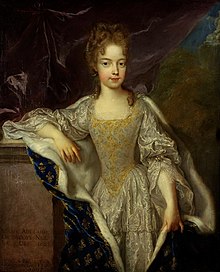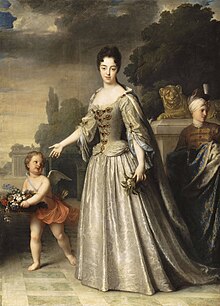Maria Adelaide of Savoy

Maria Adelaide of Savoy (French: Marie-Adélaïde de Savoie ) (* December 6, 1685 in Turin , † February 12, 1712 in the Palace of Versailles ) was Princess of Savoy due to her birth descent and due to her marriage to Louis , the eldest Grandson of King Louis XIV of France, Duchess of Burgundy since 1697 and Dauphine of France since 1711 . She was the mother of King Louis XV. She died of measles in 1712 at the age of only 26 .
Parentage and childhood
Marie Adelaide was the eldest daughter of Viktor Amadeus II , Duke of Savoy, and his first wife Anne Marie d'Orléans . This made her maternal granddaughter of Duke Philippe I d'Orléans and great-niece of King Louis XIV of France. Her mother almost died when she was born. Her godparents were her paternal grandmother, Maria Johanna von Savoyen , and Emmanuel Philibert von Savoyen-Carignan .
Contrary to the custom of the time, Marie Adelaide was raised by her mother herself. She had a close relationship with both her mother and her grandmother Maria Johanna. Her governess was the Countess Dunoyer. Her younger sister Maria Luisa Gabriella was to marry Philip V of Spain in 1701 . Marie Adelaide had other siblings, including Karl Emanuel III. who became King of Sardinia-Piedmont in 1730.
marriage

First Viktor Amadeus II wanted to marry his eldest daughter to Archduke Joseph , but because of her too young age, Emperor Leopold I refused.
In 1696, Louis XIV tried to bring the War of the Palatinate Succession to an end and, for this purpose, to separate Viktor Amadeus II as the first monarch from the enemy coalition by means of peace talks. After tough negotiations, the Treaty of Turin, which was initially kept secret and signed on June 29, 1696, resulted in a separate peace between the French king and the Duke of Savoy, including the marriage of Marie Adelaide to Louis de Bourbon, dauphin de Viennois provided.
On October 15, 1696 Marie Adelaide crossed the border river Guiers at Le Pont-de-Beauvoisin, which separated Savoy from France without taking a retinue with her. The Duke de Brionne picked her up in a carriage and traveled with her inland. On November 4, 1696, King Louis XIV personally expected her in Montargis, south of Paris . He was enthusiastic about the witty and exuberant eleven-year-old girl and wrote to his partner, Madame de Maintenon , that Marie Adelaide was very graceful and well-built, had lively eyes and beautiful black hair and that she had behaved very politely and well-mannered towards him.
Since Marie Adelaide was still too young, she was initially not married and kept away from her future husband. For further training, she attended the girls' school Maison Royale de Saint-Louis in Saint Cyr near Versailles, founded by Madame de Maintenon in 1684 . At the earliest possible legal date (December 7, 1697), the 12-year-old future Dauphine and the Duke of Burgundy, the eldest son of the Grand Dauphin , married with great pomp in Versailles. The bride wore a silver dress covered with rubies and provided with an 8-meter-long train. The marriage has not yet been consummated because of the bride's youth.
Favorite of the king
Louis XIV visibly revived Marie Adelaide's childish jokes. Until her death she was the declared darling of the aging king, whom she constantly knew how to amuse and cheer up. Marie Adelaide was soon able to win over Madame de Maintenon, whom she addressed confidentially as " ma tante ". She enjoyed freedoms in Versailles like hardly any other member of the royal family. The king even preferred them to his grandson. She often wrote to her family about her extraordinarily friendly relationship with the king, which annoyed his illegitimate but legitimate daughters.
The wife of Louis XIV, Marie Thérèse , had already died in 1683, and now, despite her youth, Marie Adelaide was the first lady of his court for the king . She was allowed to take on the role of queen in representative acts. In Versailles she lived in the magnificent apartments of the various queens, which were renovated according to her taste and were on the same floor as those of the king and Madame de Maintenon.
progeny
Marie Adelaide and her husband, the Duke of Burgundy, eventually took up a normal married life and had three sons:
- Ludwig, 1st Duke of Brittany (* June 25, 1704, † April 13, 1705)
- Ludwig, 2nd Duke of Brittany (January 8, 1707, † March 8, 1712)
- Ludwig, Duke of Anjou (* February 15, 1710, † May 10, 1774), since 1715 as Louis XV. King of France.
Louis XIV was very satisfied with the birth of his sons, as this seemed to secure his succession.
Court intrigues
Marie Adelaide loved jewelry and amusements, attended numerous balls, hunts, games, and banquets, and was often the focal point of the court she enchanted. She did not share her husband's extremely religious inclinations at all and once remarked to Louis XIV that if she died before her husband and could return to earth afterwards, he would find him married to a nun.

Even in the field of politics, Marie Adelaide dared to crack jokes and asked Madame de Maintenon one evening, in the presence of Louis XIV, why England was ruled better under a queen than under a king, and answered herself that the country was under a king of Women will be ruled and under a queen by men. Marie Adelaide mocked the vine of Louis XIV's secret wife. Nevertheless, the king was amused by her somewhat malicious remark.
Through her influence on Louis XIV, the young Duchess of Burgundy tried to keep her political enemies, who rallied around her father-in-law, the presumptive heir to the throne, in check. Her greatest opponent was the Countess Louise Françoise de Bourbon , a legitimate daughter of Louis XIV of his former mistress Madame de Montespan . The Countess of Bourbon tried to marry her daughter Louise Élisabeth de Bourbon to the Duke Charles von Berry , the youngest son of the Grand Dauphin , who, however, at Marie Adelaide's instigation, was rather the husband of Marie Louise Élisabeth d'Orléans , the eldest daughter of the Duke Philip II of Orléans , was. Through Marie Adelaide's influence, the French general Louis Joseph, Duke of Vendôme , also fell out of favor .
Marie Adelaide often took part in political deliberations and was privy to many important state secrets and decisions. According to the French historian Charles Pinot Duclos , she is said to have misused her knowledge by giving her father all information of interest to him. This came to light after her death after looking through her letters. Accordingly, Louis XIV is said to have told Madame de Maintenon that the “little woman” had deceived him.
The French sculptor Antoine Coysevox made a statue of Marie Adelaide in 1710, which portrayed her as the goddess Diana and was kept in the Louvre .
Death and Succession

When the previous heir to the throne, the Grand Dauphin , died of chickenpox on April 14, 1711, his son, the 29-year-old Duke of Burgundy, was promoted to crown prince and his wife Marie Adelaide to dauphine, a position that she only ten months should hold. Because in 1712 a measles epidemic broke out, and both the Duke and Duchess of Burgundy succumbed to the disease, as did their oldest living son, the five-year-old Duke of Brittany. Marie Adelaide fell ill at Fontainebleau Palace , where the court was stopping, and died on February 12, 1712 in Versailles. Shortly before her death, the 26-year-old Dauphine is said to have said to the Duchess of Guise: “Goodbye, beautiful Duchess, alluding to her transience, also in the memory of the Versailles court. Dauphine today, nothing tomorrow, forgotten the day after tomorrow. ”Her dearly loving husband, who was infected with her, died just six days later, on February 18, in Marly-le-Roi . Marie Adelaide was buried with her husband on February 23rd in the Basilica of Saint-Denis . The little Duke of Brittany died on March 8, 1712.
Perhaps all three deaths were caused by the apparently too violent bloodletting ordered by overzealous doctors. Only the youngest son, Marie Adelaide, the little Duke of Anjou, survived because his governess, Madame de Ventadour , withdrew him from the deadly care of the doctors. For Louis XIV, these family deaths, which occurred within such a short space of time, were a tragedy. He particularly mourned the deceased Dauphine and shared his grief with King Philip V of Spain in a letter.
Since all legitimate heirs of Louis XIV had died except for the Duke of Anjou, who was only two years old, the old king elevated his illegitimate sons to the rank of Princes of the Blood in 1714 and even offered them the prospect of succession to the throne if the Duke of Anjou died. However, this case never occurred, since King Louis XV from the Duke of Anjou in 1715 . of France, for whom the late monarch had appointed his nephew, Philip II of Orléans , as regent.
literature
- Warren Hamilton Lewis: Louis XIV. The Sun King . Heyne, Munich, ISBN 3-453-55034-X .
Web links
Remarks
- ↑ Bernd-Rüdiger Schwesig: Ludwig XIV. 3rd edition. 1993, ISBN 3-499-50352-2 , pp. 107-108.
- ↑ Bernd-Rüdiger Schwesig: Ludwig XIV. 3rd edition. 1993, ISBN 3-499-50352-2 , p. 110
- ↑ Uwe Schultz : The ruler of Versailles: Ludwig XIV and his time . 1st edition. Beck, Munich 2006, ISBN 3-406-54989-6 , pp. 334–335 ( limited preview in Google Book search).
- ↑ Uwe Schultz: Ludwig XIV. And his time. 2006, p. 336.
- ^ Marie-Adelaïde de Savoie. In: Nouvelle biography générale. Volume 33, 1860, Col. 730.
- ↑ Uwe Schultz: Ludwig XIV. And his time. 2006, p. 336.
- ^ Marie-Adelaïde de Savoie. In: Nouvelle biography générale. Volume 33, 1860, Col. 730-731.
- ↑ Uwe Schultz: Ludwig XIV. And his time. 2006, p. 380.
- ^ Marie-Adelaïde de Savoie. In: Nouvelle biography générale. Volume 33, 1860, Col. 731.
- ↑ Bernd-Rüdiger Schwesig: Ludwig XIV. (1993), p. 126ff .; Uwe Schultz: Ludwig XIV. And his time (2006), pp. 380–383.
| personal data | |
|---|---|
| SURNAME | Savoy, Maria Adelaide of |
| ALTERNATIVE NAMES | Savoie, Marie-Adélaïde de |
| BRIEF DESCRIPTION | Duchess of Burgundy, mother of Louis XV. |
| DATE OF BIRTH | December 6, 1685 |
| PLACE OF BIRTH | Turin |
| DATE OF DEATH | February 12, 1712 |
| Place of death | Palace of Versailles |
